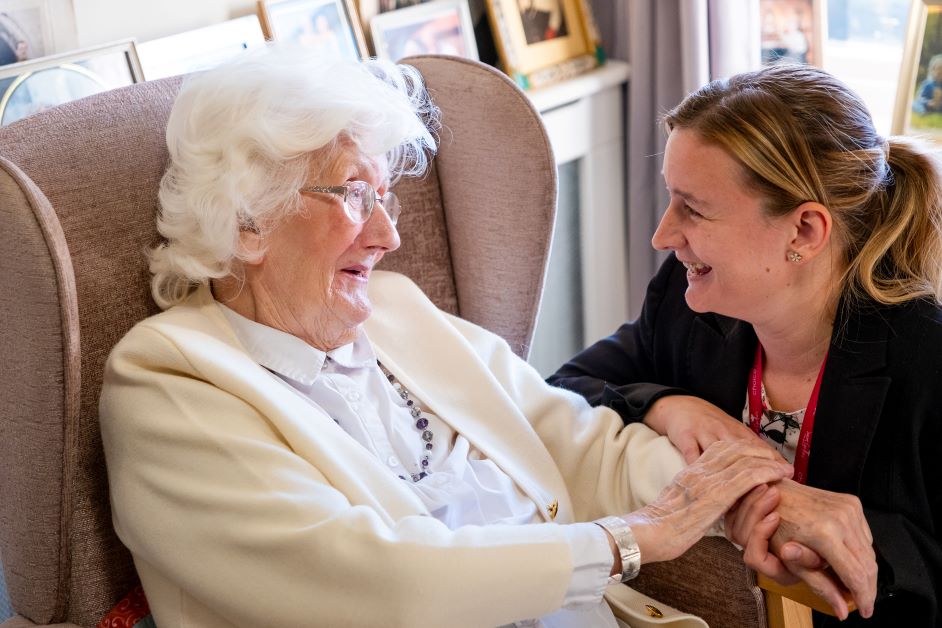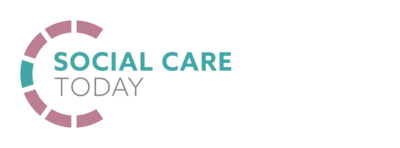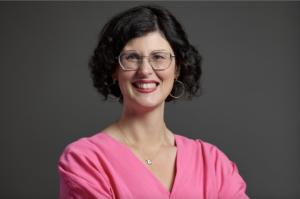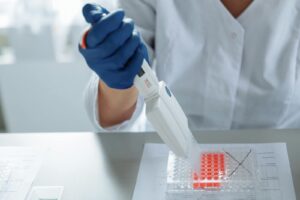Interview: Reducing falls in care homes with Earzz acoustic monitoring
Dr. Pradyumna Thiruvenkatanathan, Founder and CEO of Earzz, tells us how intelligent acoustic monitoring can transform the provision of care, with benefits for residents and staff…
What is an ‘acoustic monitor’? I’m imagining something like a souped-up baby monitor.
That’s a nice way of putting it! With a typical baby monitor, you have a transmitter in the baby’s room and then the parent has a little receiver, with audio fields and maybe flashing lights to alert them to any sort of concern in the room. That basic concept has been adopted in care homes.

Betsey, a resident at Alba Rose Care Home in Pickering where Earzz has been trialled, with care home manager Tanya Wormald; photo courtesy of Saint Cecilia’s Care Group
The issue in a care home is that you’re often monitoring several rooms at a time. If you’re using something along the lines of a baby monitor, you need a carer sat at the receiver, actively listening to the different audio feeds and then deciding if there’s a problem requiring someone being dispatched to help. Carers are employed to provide care, not to puzzle over radio feeds!
Your system does something different.
It’s completely different. Earzz acoustic pods have the intelligence to recognise certain specific sounds of concern in a room and discern differences between them. The system can tell if a person is coughing, gasping or even screaming. It can recognise footsteps, or a bed creaking as a person moves around. The system then alerts the carers, without them having to waste time listening to audio data and cutting down the need for unnecessary room checks.
Why are room checks a problem?
It’s the same reason people use baby monitors: if you go into the room to check the baby is all right, the baby might wake up. Imagine being a resident in a care home where a carer looks in every one or two hours during the night. Once disturbed, a resident may have difficulty getting back to sleep and may get restless or even get out of bed. That can mean more work for carers.
How complex is it to install the Earzz monitoring system?
It’s fairly simple, really. Each acoustic monitor is a little cube, a smart device that can fit in your hand. You install that next to the resident’s bed. You then configure it to listen out for specific sounds relevant to that person — there’s a menu on the app and you choose the options that apply, tailoring it to their needs. When those sounds are detected, an alert is sent.
How do the alerts work — is it like an alarm?
It’s a push notification, almost like a WhatsApp message, which says ‘Movement noise heard in Room X.’ That’s sent out to all the carers on duty, with the question, ‘Will you be attending?’ If a carer answers ‘Yes’, all the other carers see that — so they know they don’t have to respond. That’s important because, as I’m sure you know, carers are often busy.
The carer who said ‘Yes’ then attends the resident and the first thing they do is press the big, square button on the top of the acoustic monitor. That digitises their presence in the room, providing data to evidence that care.
Why is that data useful?
With our system, you can show that, say, within three minutes of a problem being detected a carer was in that room. That’s important because care homes increasingly need to be able to show evidence of their responsiveness and safety measures. It’s important to the families of the residents and it’s one of the key pillars for the Care Quality Commission in regulating the sector.
It also means care home managers can track responses and see which rooms do or don’t get well attended. That all helps drive operational efficiency. We provide all those metrics on a dashboard so that managers can easily access and understand what’s going on. By providing insights beyond the basic alert of a problem, we can help transform operational practice in the care home.
In addition, by logging all the data about different kinds of sounds detected, we can help with the management of care being given. Pain management is a big factor here. We can show patterns of behaviour, such as that a resident cries out at particular intervals in the night, suggesting they’re in pain. The carers can then administer medication a little earlier or later to match that evidence, and the result is the resident gets a better night’s sleep.
This data can also help with infection control because it shows when a person is coughing. Compare that to data from different rooms in the care home and you can follow the spread of infection and the effectiveness of measures to stop it. And it can help to provide insights into the behavioural patterns of a resident with specific complex needs: you can see exactly when they become active and when they sleep, and adjust provision to match.
Your website says the system helps ‘prevent falls especially during the night’. How?
First, we should say why this is such a big issue in elderly care. The NHS spends £2.3bn annually on falls. There’s the cost of the immediate response to the fall, sending out an ambulance and so on. But then there are the problems that might follow a fall: surgery, hip replacement, follow-ups and so on. For the care homes, a fall often means a carer sits with the resident until the ambulance arrives, so can’t do other work or help other people. They then have to catalogue the fall and do all the admin — which can often take hours. A fall can do psychological damage to the resident and to the carers. It can affect the reputation of a home. There are all these different impacts.
In care homes, we can reduce the number of falls by understanding the sounds in a resident’s room. We can tell if a resident is coughing or gasping or moving around, those kinds of signs of increased anxiety, and we can notify a carer who then attends before the resident falls. The carer can help the resident get out of bed and go to the toilet. Or they can help settle a resident who is anxious or has something on their mind. That happens with residents living with Alzheimer’s and other kinds of dementia — they can suddenly have a sense of purpose and want to walk around. We can help get a carer to them before they start walking, and that drastically reduces the chances of a fall.
How many falls do you prevent?
We have several case studies now. The Armscare Group installed our acoustic monitoring system in a care home in Norfolk this summer and over a five-week period the number of falls dropped from 13 to two – a reduction of more than 80%.
St Cecilia’s Care Group saw a 100% reduction in falls. There had been four falls in the same period before they installed our system, and then there were none. They also saw an 80% reduction in unnecessary physical room checks in the night, and a 55% improvement in resident’s sleep.
[This impressive claim was confirmed for us by Mike Higginson, Managing Director of Saint Cecilia’s Care Group, who says: ‘We are seeing our residents really benefit from this technology. We are seeing them have improved sleep, less falls and improved appetite. Like anyone, when you are well rested your day can be more enjoyable after a good night’s sleep. As a group, we’re looking to extend the rollout of Earzz acres out homes so that more people benefit.’]
What would you like to do next with this technology?
We’re already looking at ways to apply this to help people who are deaf or hard-of-hearing, so it provides them with an alert if the doorbell rings or there’s an alarm. We’re looking at in-home applications, too.
But in care homes, we’re also looking at how we can better integrate what we’re doing with digital social care record-keeping systems, which would make things easier for managers to use and apply our data in planning. Streamlining that process is important so staff spend less time on admin and more time focus on care.
Dr Thiruvenkatanathan, thank you. For more information, see the Care homes and assistant living section of the Earzz website.
In related news:
In the shadows of short-staffing: Health impacts on care managers
Ministers launched inquiry into cost of disregard on social care reform















